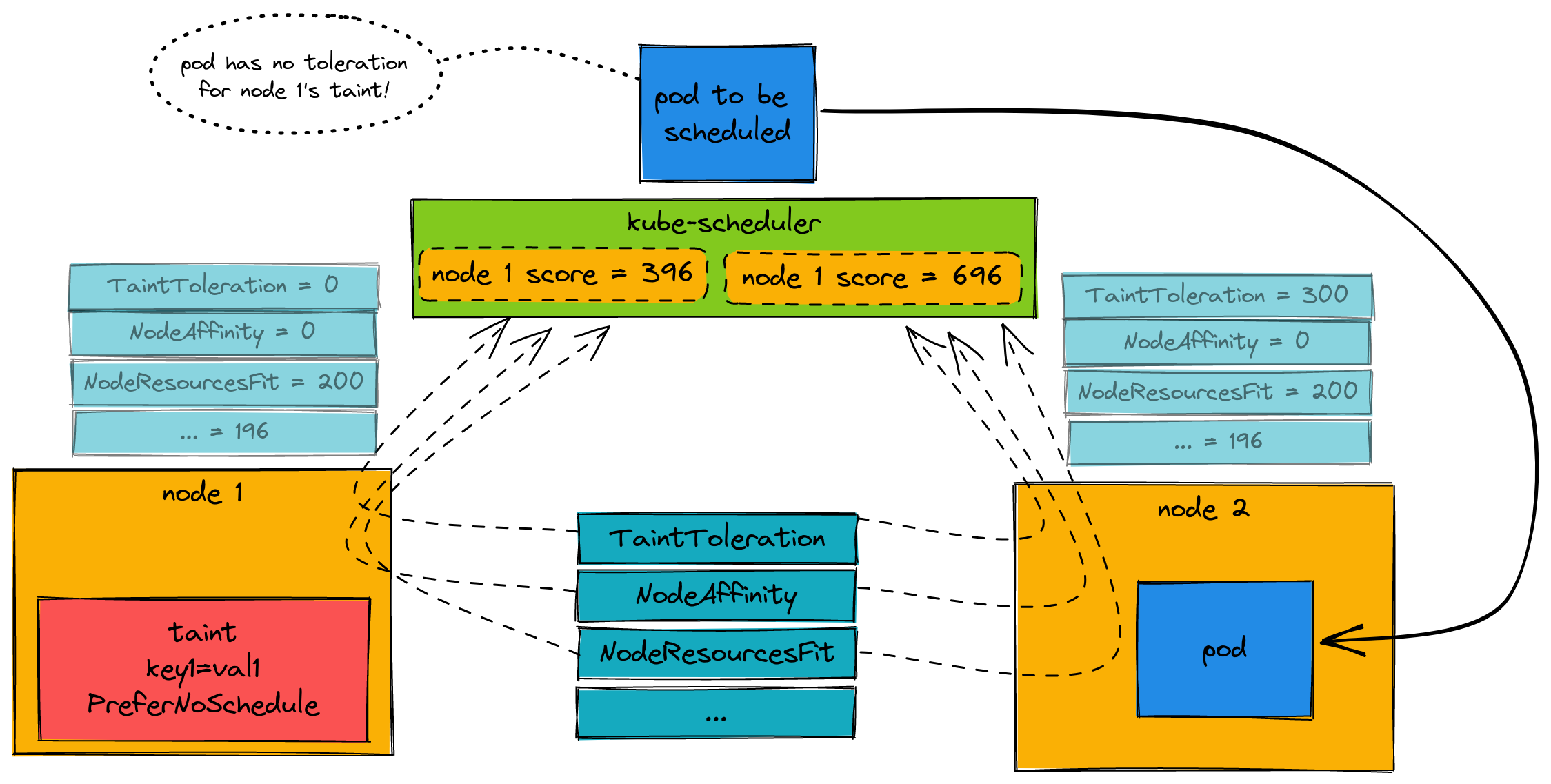Within a Kubernetes cluster, it is common to want to stop pods from being scheduled on a node, or even terminated if they are already scheduled. These are referred to as taints (on the node) and tolerations (on the pods that want to be scheduled on a node). Taints and tolerations are comprised of three different components: Key, value, and effect. When you create a taint on a node, you specify all three of those:
1
$ kubectl taint node <node_name> <key>=<value>:<effect>
There are three different effects:
NoExecute- Any pods that are already on the node that don’t tolerate this taint will be evicted. New pods without a toleration will not be scheduled on this node.NoSchedule- Any new pods that don’t have a toleration for this taint will not be schedule on this node.PreferNoSchedule- More below…
While NoExecute and NoSchedule are straightforward, the Kubernetes documentation explains PreferNoSchedule as:
if there is no un-ignored taint with effect NoSchedule but there is at least one un-ignored taint with effect PreferNoSchedule then Kubernetes will try to not schedule the pod onto the node
That’s not a very concrete answer, and when determining what your taints and tolerations are could be impacted by what that really means.
To understand how Kubernetes handles the PreferNoSchedule taint, it’s important to first understand how a pod’s destination node is determined. What’s happening is that kube-scheduler will try to find a node that a new pod can be scheduled on. Part of that process is determining which is the best node. Kubernetes has the notion of score plugins for potential and possible nodes for a new pod. There are a handful of plugins, and one of them is the TaintToleration plugin, which a PreferNoSchedule taint (and lack of toleration) will affect. After Kubernetes calculates the score of each individual plugin per node, it aggregates them (by node). The node with the highest score is the one that will get the pod scheduled on it. Let’s see this illustrated:

In this scenario, because node1 has a taint with PreferNoSchedule, and the pod that should be scheduled doesn’t have a toleration for this then it will have an impact in the node’s overall score. In the end, because of the TaintToleration plugin, node2 has a higher score than node1 and therefore the pod gets scheduled on node2. But! Even with the PreferNoSchedule taint, you can see above that other factors and score plugins could still cause the pod to be scheduled on node1. That’s why it’s a soft preference, and not a hard requirement (like NoSchedule).
Let’s see this in a demo. First I’ll create my local kind cluster (adding in a kubeadm patch so that kube-scheduler has verbose logging):
scheduler-verbose-logging.yaml
1
2
3
4
5
6
7
8
9
10
11
12
kind: Cluster
apiVersion: kind.x-k8s.io/v1alpha4
nodes:
- role: control-plane
kubeadmConfigPatches:
- |
kind: ClusterConfiguration
scheduler:
extraArgs:
v: "10"
- role: worker
- role: worker
1
$ kind create cluster --config ./scheduler-verbose-logging.yaml
My Kubernetes cluster nodes look like this:
1
2
3
4
5
$ kubectl get no
NAME STATUS ROLES AGE VERSION
kind-control-plane Ready control-plane 105m v1.25.2
kind-worker Ready <none> 105m v1.25.2
kind-worker2 Ready <none> 105m v1.25.2
I want to create a taint on kind-worker node:
1
2
$ kubectl taint node kind-worker key1=val1:PreferNoSchedule
node/kind-worker tainted
The taint has key key1 with a value of val1 and an effect of PreferNoSchedule. Now let’s create a simple pod:
pod.yaml
1
2
3
4
5
6
7
8
9
apiVersion: v1
kind: Pod
metadata:
name: taint-toleration-test
spec:
containers:
- name: httpbin2
image: ghcr.io/trstringer/httpbin2:latest
command: ["/httpbin2"]
This pod doesn’t have a toleration for kind-worker’s taint, and as expected it gets scheduled on the other node (kind-worker2):
1
2
3
$ kubectl get po -o wide
NAME READY STATUS RESTARTS AGE IP NODE NOMINATED NODE READINESS GATES
taint-toleration-test 1/1 Running 0 36m 10.244.2.2 kind-worker2 <none> <none>
Let’s see what the kube-scheduler pods show!
1
2
3
4
5
6
7
8
9
10
11
12
13
14
15
16
17
18
19
schedule_one.go:646] "Plugin scored node for pod" pod="default/taint-toleration-test" plugin="VolumeBinding" node="kind-worker2" score=0
schedule_one.go:646] "Plugin scored node for pod" pod="default/taint-toleration-test" plugin="VolumeBinding" node="kind-worker" score=0
schedule_one.go:646] "Plugin scored node for pod" pod="default/taint-toleration-test" plugin="PodTopologySpread" node="kind-worker2" score=200
schedule_one.go:646] "Plugin scored node for pod" pod="default/taint-toleration-test" plugin="PodTopologySpread" node="kind-worker" score=200
schedule_one.go:646] "Plugin scored node for pod" pod="default/taint-toleration-test" plugin="InterPodAffinity" node="kind-worker2" score=0
schedule_one.go:646] "Plugin scored node for pod" pod="default/taint-toleration-test" plugin="InterPodAffinity" node="kind-worker" score=0
schedule_one.go:646] "Plugin scored node for pod" pod="default/taint-toleration-test" plugin="NodeResourcesBalancedAllocation" node="kind-worker2" score=99
schedule_one.go:646] "Plugin scored node for pod" pod="default/taint-toleration-test" plugin="NodeResourcesBalancedAllocation" node="kind-worker" score=99
schedule_one.go:646] "Plugin scored node for pod" pod="default/taint-toleration-test" plugin="ImageLocality" node="kind-worker2" score=0
schedule_one.go:646] "Plugin scored node for pod" pod="default/taint-toleration-test" plugin="ImageLocality" node="kind-worker" score=0
schedule_one.go:646] "Plugin scored node for pod" pod="default/taint-toleration-test" plugin="TaintToleration" node="kind-worker2" score=300
schedule_one.go:646] "Plugin scored node for pod" pod="default/taint-toleration-test" plugin="TaintToleration" node="kind-worker" score=0
schedule_one.go:646] "Plugin scored node for pod" pod="default/taint-toleration-test" plugin="NodeAffinity" node="kind-worker2" score=0
schedule_one.go:646] "Plugin scored node for pod" pod="default/taint-toleration-test" plugin="NodeAffinity" node="kind-worker" score=0
schedule_one.go:646] "Plugin scored node for pod" pod="default/taint-toleration-test" plugin="NodeResourcesFit" node="kind-worker2" score=97
schedule_one.go:646] "Plugin scored node for pod" pod="default/taint-toleration-test" plugin="NodeResourcesFit" node="kind-worker" score=97
schedule_one.go:704] "Calculated node's final score for pod" pod="default/taint-toleration-test" node="kind-worker2" score=696
schedule_one.go:704] "Calculated node's final score for pod" pod="default/taint-toleration-test" node="kind-worker" score=396
default_binder.go:52] "Attempting to bind pod to node" pod="default/taint-toleration-test" node="kind-worker2"
The scheduler shows the score plugin (and resulting score) for each node when trying to schedule, and ends up with the following:
| plugin | kind-worker | kind-worker2 |
|---|---|---|
| VolumeBinding | 0 | 0 |
| PodTopologySpread | 200 | 200 |
| InterPodAffinity | 0 | 0 |
| NodeResourcesBalancedAllocation | 99 | 99 |
| ImageLocality | 0 | 0 |
| TaintToleration | 0 | 300 |
| NodeAffinity | 0 | 0 |
| NodeResourcesFit | 97 | 97 |
| TOTAL | 396 | 696 |
Finally, kind-worker2 has a higher score and gets the pod. Hopefully this exercise has shown you that while a PreferNoSchedule taint (and lack of toleration) has an impact in pod scheduling, there are other factors involved which could end up affecting the final destination node!
